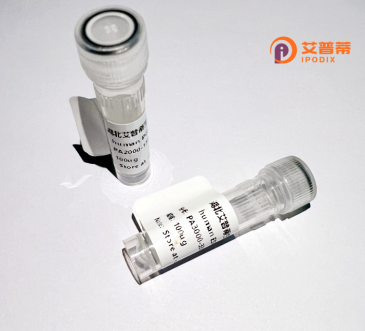
| 纯度 | >90%SDS-PAGE. |
| 种属 | Human |
| 靶点 | C9orf72 |
| Uniprot No | Q96LT7 |
| 内毒素 | < 0.01EU/μg |
| 表达宿主 | E.coli |
| 表达区间 | 1-481aa |
| 氨基酸序列 | MSTLCPPPSP AVAKTEIALS GKSPLLAATF AYWDNILGPR VRHIWAPKTE QVLLSDGEIT FLANHTLNGE ILRNAESGAI DVKFFVLSEK GVIIVSLIFD GNWNGDRSTY GLSIILPQTE LSFYLPLHRV CVDRLTHIIR KGRIWMHKER QENVQKIILE GTERMEDQGQ SIIPMLTGEV IPVMELLSSM KSHSVPEEID IADTVLNDDD IGDSCHEGFL LNAISSHLQT CGCSVVVGSS AEKVNKIVRT LCLFLTPAER KCSRLCEAES SFKYESGLFV QGLLKDSTGS FVLPFRQVMY APYPTTHIDV DVNTVKQMPP CHEHIYNQRR YMRSELTAFW RATSEEDMAQ DTIIYTDESF TPDLNIFQDV LHRDTLVKAF LDQVFQLKPG LSLRSTFLAQ FLLVLHRKAL TLIKYIEDDT QKGKKPFKSL RNLKIDLDLT AEGDLNIIMA LAEKIKPGLH SFIFGRPFYT SVQERDVLMT F |
| 分子量 | 54.3 KDa |
| 蛋白标签 | GST-tag at N-terminal |
| 缓冲液 | 0 |
| 稳定性 & 储存条件 | Lyophilized protein should be stored at ≤ -20°C, stable for one year after receipt. Reconstituted protein solution can be stored at 2-8°C for 2-7 days. Aliquots of reconstituted samples are stable at ≤ -20°C for 3 months. |
| 复溶 | Always centrifuge tubes before opening.Do not mix by vortex or pipetting. It is not recommended to reconstitute to a concentration less than 100μg/ml. Dissolve the lyophilized protein in distilled water. Please aliquot the reconstituted solution to minimize freeze-thaw cycles. |
以下是关于重组人C9orf72蛋白的3篇代表性文献,简要概括作者及核心发现:
1. **文献名称**:*C9orf72 is a GDP-GTP exchange factor for Rab8a and Rab39b and regulates autophagy*
**作者**:Levine T.P. et al. (2020)
**摘要**:研究发现重组人C9orf72蛋白与SMCR8和WDR41形成复合物,具有鸟苷酸交换因子(GEF)活性,激活RAB8A和RAB39B,调控自噬体和溶酶体融合,提示其在神经退行性疾病中的功能机制。
2. **文献名称**:*The C9orf72 protein interacts with Rab1a and the ULK1 complex to regulate initiation of autophagy*
**作者**:Sullivan P.M. et al. (2016)
**摘要**:揭示C9orf72通过结合Rab1a和ULK1复合体,促进自噬起始。ALS/FTD相关C9orf72突变导致自噬缺陷,支持其在蛋白降解通路中的关键作用。
3. **文献名称**:*C9orf72 regulates membrane traffic and liquid-liquid phase separation of ALS-linked proteins*
**作者**:Shi G. et al. (2022)
**摘要**:发现C9orf72通过维持内溶酶体功能,调控TDP-43和FUS等RNA结合蛋白的液-液相分离。其缺失导致应激颗粒异常聚集,可能与神经退行性疾病相关。
以上研究围绕C9orf72的分子功能、自噬调控及相分离机制展开,为理解其在ALS/FTD中的作用提供了关键线索。
The C9orf72 protein, encoded by the chromosome 9 open reading frame 72 gene, has gained significant attention due to its association with neurodegenerative disorders, particularly amyotrophic lateral sclerosis (ALS) and frontotemporal dementia (FTD). The most common genetic cause of these diseases is a pathogenic hexanucleotide repeat expansion (GGGGCC) in the C9orf72 gene, which leads to toxic RNA foci, dipeptide repeat proteins (DPRs), and/or haploinsufficiency of the C9orf72 protein.
C9orf72 is widely expressed in neurons and immune cells, suggesting roles in both neurological and immune system functions. Structurally, it contains a Dennd3-like domain, homologous to guanine nucleotide exchange factors (GEFs) involved in membrane trafficking. Studies suggest C9orf72 regulates autophagy, lysosomal function, and vesicular transport, critical for neuronal health. Reduced C9orf72 levels in ALS/FTD may impair these processes, contributing to neurodegeneration.
Recombinant human C9orf72 protein is engineered for in vitro studies to elucidate its physiological functions and disease mechanisms. Researchers use it to explore protein interactions, autophagy pathways, and the effects of pathogenic mutations. Understanding C9orf72's normal and dysregulated roles remains vital for developing targeted therapies for ALS/FTD. Current research focuses on how loss of function, RNA toxicity, or DPR accumulation drives disease, aiming to identify biomarkers and therapeutic interventions.
×